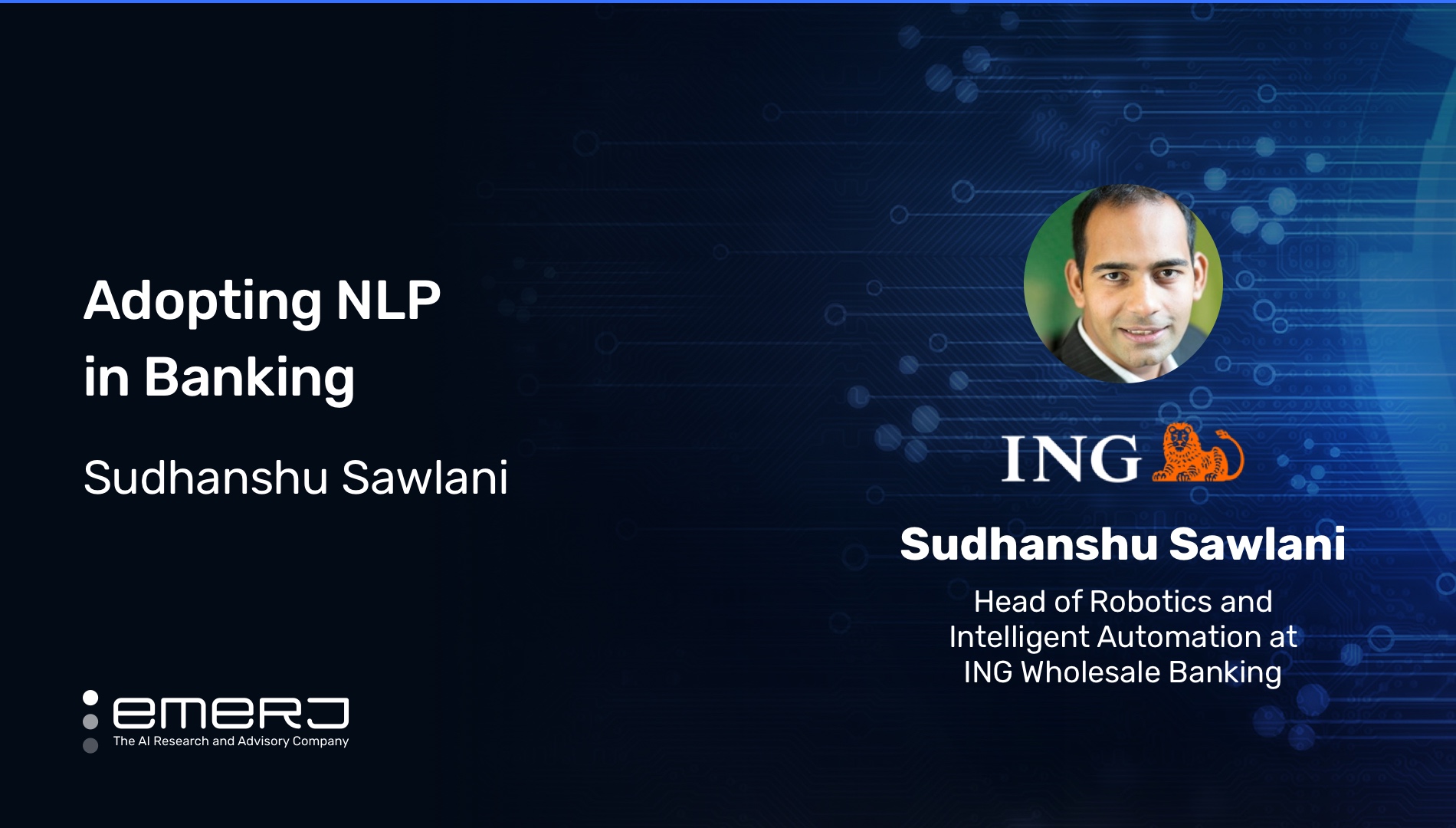Bringing NLP to Banking – with Sudhanshu Sawlani of ING
AI is coming to banking and picking up speed. In a 2020 survey conducted by PwC Research, banks cited increased productivity and efficiencies, just ahead of revenue growth, as their top goal for their AI initiatives.
However, those same banks see their top AI challenges in its design and convergence with existing technologies. The most cited challenge in the study was the ability of employees to acclimate to the technology based on training, including while working remotely.
As banks move forward into their respective digital transformations, they are looking at the design and execution of AI projects and how to extract the most ROI for their investments of time, money, and resources. For NLP, specifically, banks are exploring how the technology can support enterprise search, 360-degree unified customer views change the way they serve their customers.
What does the adoption of a successful AI project look like in the banking world? What are some of the challenges banks face in adopting AI and NLP? What strategies have worked in moving an AI project from pilot to deployment?
We recently met with Sudhanshu Sawlani, Head of Robotics, & Intelligent Automation at ING Wholesale Banking for an in-depth look at NLP adoption in banking. In our 30-minute interview, we explore an NLP use case that he has implemented across different units within ING. We focus on three primary topics:
- Prioritizing a High-ROI NLP Use Case: By identifying the core business problem that underlies an NLP use case, we can evaluate its viability, determine how to best structure the project, and clearly communicate its value to the enterprise.
- Overcoming Common AI Challenges: ING identified the business task it wanted to confront
:as the enormous amount of time lost to administrative tasks faced by its customer loyalty team. - Moving AI from Pilot to Deployment: To avoid the pilot-phase deaths suffered by many other AI projects, ING invested significant up-front effort and training to ensure that the solution delivered accuracy, efficiency, and ROI.
Listen to the full episode below:
Guest: Sudhanshu Sawlani, Head of Robotics & Intelligent Automation at ING Wholesale Banking
Expertise: RPA, process automation, project management, user acceptance testing
Brief Recognition: Before heading ING’s robotics and intelligent automation CoE in 2019, Sudhanshu held various positions within ING, including Product Owner, Business Analyst, and SEPA Migration Consultant. Earlier in his career, he held positions at HSBC in the UK and India. He completed his university degrees at Rotterdam School of Management at Erasmus University, the University of Cologne, and Georgetown University.
Prioritizing a High-ROI NLP Use Case
When you ideate potential NLP use cases, be sure you can identify—clearly—the business problems they will address. If you can identify the business problem that underlies a use case, this helps you communicate the use case’s value to management, and to structure its goals, objectives, and milestones. At this stage of defining high-ROI NLP use cases, you can start by asking value-defining questions like:
- What are the elements of my business problem?
- What is the financial or measurable metric we want to improve?
- What are the workflows or processes that must be changed in order to move that metric?
As an industry, banking directs so many resources toward customer support and solving customer problems. Unfortunately, when banking customers call in for customer support, they often encounter Byzantine systems and long hold times. Even worse, they find themselves buried in paperwork-heavy processes that lead to delays and confusion.
In ING’s example, their business problem turned out to be that a large number of customer emails landed in support team mailboxes each day, but the support teams that received the emails were not always equipped to provide the full and final solution to each customer’s problem.
“We want to empower them, but they always have dependencies. The first thing we do is register the email into a ticket. … That’s exactly the challenge—to register the ticket into the ticketing system and assign it to the right department. It’s a burden that we don’t want to give to the support team.”
Sudhanshu Sawlani, Head of Robotics & Intelligent Automation at ING Wholesale Banking
The support team often has dependencies on other back-office teams. Consequently, registering the ticket becomes critical in assigning the issue to the right team. Eliminating time, resources, and customer frustration from the process can reduce administrative costs—especially at ING, reflects Sawlani, where customer emails come in from all over the world since the bank does business in more than 40 countries.
Those customer emails can come in for a variety of requests:
- Opening a new account
- Closing an existing account
- Resetting passwords
- Etc
“In banking,” reflects Sawlani, “that request can be anything.”
Selecting an NLP use case is exactly the sort of challenge that AI can help address. Registering the ticket and assigning it to the right department represents a burden that support teams don’t need. If AI can help them focus on solving the problem faster and with fewer costly resources, it can mean a great fit for a first (or next) NLP project.
ING had identified the business process it wanted to improve. The next step was to identify the workflows that had to be changed in order to achieve better customer service metrics.
Overcoming Common AI Challenges
When you’re staring into the face of a new NLP project and tasked with applying artificial intelligence into an enterprise environment, challenges always emerge, especially when you’re first starting out. Those challenges can make you question the project, it’s worth, and even why AI was on the table in the first place. Overcoming challenges in your NLP project can be rewarding and can be made easier with a strong plan and strategy.
“We’re formed by our customer loyalty teams,” says Sawlani, of ING. “They support our wholesale banking clients with their questions and concerns about different products or services.”
Before ING could even service its clients, he explains, the administrative tasks became the biggest problem in terms of time loss. The bank wanted its customer loyalty team to focus more on customer-centric activities and minimize administrative burden. ING needed its customer loyalty team to focus more on activities that directly supported and/or mattered to customers.
The first NLP project challenge that ING faced was how to take its tremendous volume of inquiries, assign a category to each, and get those inquiries in front of somebody who could solve them.
ING confronted the challenge by framing its solution: AI that would deliver the customer’s issue to the person with the best expertise, authority, and experience to solve it.
The bank saw automation as the starting point that could facilitate this initial part of the process: when the email was received, classified, and dispatched as a service request.
“What we soon realized was that there can be many reasons why a customer would send us an email. When you add more countries, that magnifies the reasons. But, many rules are difficult to script into a robot.”
Sudhanshu Sawlani, Head of Robotics & Intelligent Automation at ING Wholesale Banking
To address this challenge, ING resolved to move from a rule-based solution to a model-based solution. Equipped with NLP capabilities, the AI solution would be able to receive, understand, and classify incoming emails, and in the different languages that clients from the over 40 different countries in the bank’s footprint use.
ING looked to its solution to overcome the language barriers that customer loyalty personnel faced. “We don’t want them to use the public translation system,” explained Sawlani. “We really want a compliant on-premise solution to understand the emails coming in.”
That solution was tasked with:
- Receiving the email
- Classifying the email
- Determining the identity of the person
- Matching the person with an existing record
- Assigning the ticket
To train the system, the team relied on examples for every kind of request, supplied a confidence interval, and tested the solution’s natural language processing abilities, which were “the power of the solution,” says Sawlani.
To do that, the solution needed to pull the name, email address, and other contact information from the customer email into the ticket and then match it with a client’s record. After that, the solution sent the ticket to the right queue within the right department.
When the bank’s customer loyalty team members route the client to the customer loyalty team, the idea is that the customer loyalty professional will not start with, “Who are you?” and then make the customer repeat everything from the beginning. ING aimed for a much more seamless experience.
Moving AI from Pilot to Deployment
Many AI projects die in the pilot phase and being able to shepherd a project to success is a rare—and valuable—achievement. Moving ING’s accessible NLP use case from pilot to deployment required precision, strategy, and expertise.
“We were rolling it out to two different customer support teams,” explains Sawlani. “We really wanted to have a better solution than the one we had in place.”
For ING, time-savings was one key criterion, but the bank also wanted to relieve stress on the humans that made the process run—and help them accomplish their goals. To get there, the solution needed to be accurate in understanding, classifying, and assigning emails—in other words, getting it right the first time.
To ensure that customers’ problems reached the right solutions, ING’s project team set the acceptance criteria of the solution high—at 95%—when they trained the module.
Training requires time, resources, patience, and iterations. Training the model could mean feeding thousands of emails into a new system and then pausing to see if that system classifies a customer inquiry correctly.
To sell upper management on the progress of the project and the worth of the solution, the team sought to remove the manual human hunting and pecking from the customer service process, save time and dollars, and generate ROI.
The team started with emails in one language that came into one mailbox over the last six months. Then, they asked for as many training samples as possible. “The more training data you have, the better quality the solution will deliver,” Sawlani explains.
With better quality data, it becomes easier to train the engine, detect patterns, and refine the algorithms. It takes one to two days to train a model in one language, Sawlani says.
ING started implementing the solution in the Netherlands, where Sawlani works, and by the time of the podcast in late summer 2021, the bank had already rolled it out to France, Belgium, the UK, and their shared service operation.
“We have 42 countries, but we might not need to go everywhere,” says Sawlani. “This is not only automating and introducing an AI solution in one part of the bank. It’s also utilization. It was something that we had to do manually and now it’s being done by software and even more accurately and with time savings. That becomes your asset as an organization.”







